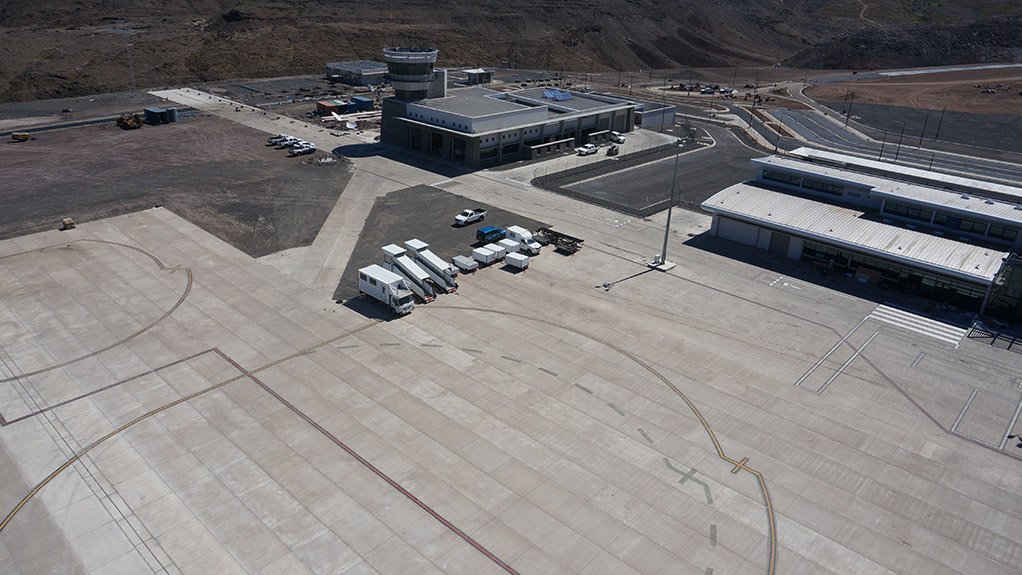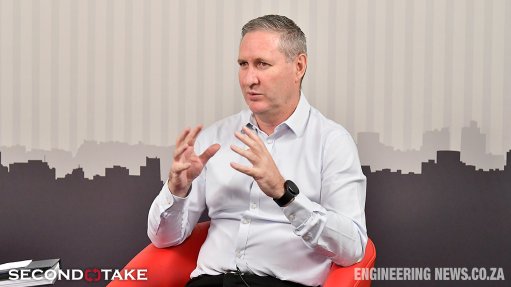UK government report slams St Helena airport development
The UK’s Department for International Development (DFID) has spent £285.5-million of British taxpayers’ money on building an airport in St Helena that is not usable by commercial airlines.
This is the main finding of a report published by the UK House of Commons Committee of Public Accounts on Wednesday.
South African construction firm Basil Read was in 2011 awarded the contract to design, build and operate the airport on St Helena.
The project included the construction of a 1 850 m concrete runway, a 3 500 m2 airport terminal and other associated infrastructure, such as access roads, bulk fuel installations, water supplies and aerodrome ground lighting.
The St Helena Airport was due to open in May this year. However, test flights in April revealed dangerous wind conditions on the airport approach – an effect known as ‘wind shear’. While the airport has since handled a small number of flights, the wind conditions have precluded operation of the planned commercial service.
The remote island – a British overseas territory 2 300 km north-west of Walvis Bay, with a population of 4 100 – was previously only accessible by ship, the Royal Mail Ship St Helena, in a journey that takes four to five days from South Africa. The new airport was built to boost tourism to the island and to make the island less dependent on aid.
The Committee of Public Accounts notes in its report, which follows an investigation into the airport project, that “it is staggering that the DFID did not foresee and address the impact of difficult wind conditions on landing commercial aircraft safely.
“The department was evasive on the question of who should be held responsible, and is yet to hold anyone to account, either internally or externally for the failure to identify this fundamental issue. Nor has it identified the extent or cost of remedial action required.”
The report notes also that there is doubt over whether the airport, when operational, will lead to St Helena becoming financially self-sufficient, owing to “significant uncertainties” over projected tourist growth figures and a lack of progress toward attracting investment.
“Thus far, the Department has unquestionably failed the residents of St Helena and the British taxpayer.”
The total amount of financial support St Helena receives from the UK government has increased from around £10-million in 1998, to almost £28-million in 2015.
Feasibility Study
The feasibility study for the St Helena airport project was completed by consultancy firm Atkins. According to the Committee of Public Accounts report, Atkins expressed doubt about the local weather conditions, including the amount of turbulence that could be expected on approaches.
The company recommended that a charter aircraft should test the approaches to the intended runway before the runway design was finalised.
Pre-construction flight testing consisted of a single flight using a propeller aircraft. However, DFID has entered into a three-year contract with the JSE-listed Comair for commercial charter flights using a different aircraft – a Boeing 737, a twin-engine jet aircraft – which is currently unable to land safely due to wind shear.
The Committee of Public Accounts report states that the DFID did not commission an independent adviser or seek support from other government departments with the necessary technical expertise to corroborate or challenge the Atkins report.
Not rushing to judgement, the DFID says it has begun a review to identify who was responsible for the decisions and actions that have led to the situation on St Helena.
No More Comair?
The Committee of Public Accounts report notes that the DFID has not yet determined the extent or cost of the remedial action required to bring the airport into commercial use.
The DFID is currently gathering data on the impact of wind shear through computer-based and physical modelling of weather conditions on the northern approach to the runway.
It is also investigating air access using the airport’s southern approach where wind shear is less of an issue, but which requires aircraft to land with a tailwind.
Landing with a tailwind places additional restrictions on the aircraft’s weight, potentially reducing passenger capacity. Aircraft normally land into the wind, where possible.
The DFID is in discussion with a number of alternative airlines to possibly provide this service because Comair, the airline currently contracted to provide a weekly commercial flight, does not have an aircraft of suitable size for landing on the southern approach, states the report.
As the department is still collecting data on wind conditions, it has not yet established a timetable for, or forecast the additional cost of, possible solutions, it adds.
“The department is also now in a potentially difficult position when it comes to negotiating the best possible deal with a new commercial air service provider, given the obvious need for it to have a new service in place as soon as possible.”
However, the report also notes that the DFID will provide its newest weather data to air service providers, such as Comair, that want to use the northern approach.
Tourism Numbers Doubtful
The report notes that the Committee of Public Accounts is “extremely sceptical” about the DFID’s projected tourism figures and the island’s ability to support such growth in the tourist industry.
In order for the island to achieve economic self-sufficiency, a significant growth in tourism is required.
In its business case for the airport, the DFID forecast that the number of tourists visiting St Helena a year would rise from just less than 1 000 to just over 29 000 by 2042.
The St Helena government is relying on investors to build the necessary infrastructure to support tourism growth. However, the investment climate on the island is not perceived as competitive internationally or regionally, in part due to factors within the St Helena government’s control, such as high corporation tax and import duties.
The St Helena government has established Enterprise St Helena to lead and champion the island’s economic development.
However, negative press reports about the airport can only have aggravated St Helena’s problems in marketing its tourist potential, states the report.
Comments
Press Office
Announcements
What's On
Subscribe to improve your user experience...
Option 1 (equivalent of R125 a month):
Receive a weekly copy of Creamer Media's Engineering News & Mining Weekly magazine
(print copy for those in South Africa and e-magazine for those outside of South Africa)
Receive daily email newsletters
Access to full search results
Access archive of magazine back copies
Access to Projects in Progress
Access to ONE Research Report of your choice in PDF format
Option 2 (equivalent of R375 a month):
All benefits from Option 1
PLUS
Access to Creamer Media's Research Channel Africa for ALL Research Reports, in PDF format, on various industrial and mining sectors
including Electricity; Water; Energy Transition; Hydrogen; Roads, Rail and Ports; Coal; Gold; Platinum; Battery Metals; etc.
Already a subscriber?
Forgotten your password?
Receive weekly copy of Creamer Media's Engineering News & Mining Weekly magazine (print copy for those in South Africa and e-magazine for those outside of South Africa)
➕
Recieve daily email newsletters
➕
Access to full search results
➕
Access archive of magazine back copies
➕
Access to Projects in Progress
➕
Access to ONE Research Report of your choice in PDF format
RESEARCH CHANNEL AFRICA
R4500 (equivalent of R375 a month)
SUBSCRIBEAll benefits from Option 1
➕
Access to Creamer Media's Research Channel Africa for ALL Research Reports on various industrial and mining sectors, in PDF format, including on:
Electricity
➕
Water
➕
Energy Transition
➕
Hydrogen
➕
Roads, Rail and Ports
➕
Coal
➕
Gold
➕
Platinum
➕
Battery Metals
➕
etc.
Receive all benefits from Option 1 or Option 2 delivered to numerous people at your company
➕
Multiple User names and Passwords for simultaneous log-ins
➕
Intranet integration access to all in your organisation




















